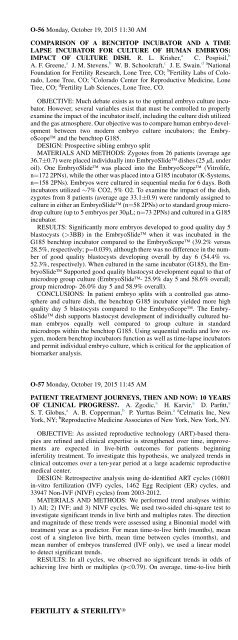You also want an ePaper? Increase the reach of your titles
YUMPU automatically turns print PDFs into web optimized ePapers that Google loves.
O-56 Monday, <strong>October</strong> 19, <strong>2015</strong> 11:30 AM<br />
COMPARISON OF A BENCHTOP INCUBATOR AND A TIME<br />
LAPSE INCUBATOR FOR CULTURE OF HUMAN EMBRYOS:<br />
IMPACT OF CULTURE DISH. R. L. Krisher, a C. Pospisil, b<br />
A. F. Greene, a J. M. Stevens, b W. B. Schoolcraft, c J. E. Swain. d a National<br />
Foundation for Fertility Research, Lone Tree, CO; b Fertility Labs of Colorado,<br />
Lone Tree, CO; c Colorado Center for Reproductive Medicine, Lone<br />
Tree, CO; d Fertility Lab Sciences, Lone Tree, CO.<br />
OBJECTIVE: Much debate exists as to the optimal embryo culture incubator.<br />
However, several variables exist that must be controlled to properly<br />
examine the impact of the incubator itself, including the culture dish utilized<br />
and the gas atmosphere. Our objective was to compare human embryo development<br />
between two modern embryo culture incubators; the EmbryoScopeÔ<br />
and the benchtop G185.<br />
DESIGN: Prospective sibling embryo split<br />
MATERIALS AND METHODS: Zygotes from 26 patients (average age<br />
36.70.7) were placed individually into EmbryoSlideÔ dishes (25 mL under<br />
oil). One EmbryoSlideÔ was placed into the EmbryoScopeÔ (Vitrolife,<br />
n¼<strong>17</strong>2 2PNs), while the other was placed into a G185 incubator (K-Systems,<br />
n¼158 2PNs). Embryos were cultured in sequential media for 6 days. Both<br />
incubators utilized 7% CO2, 5% O2. To examine the impact of the dish,<br />
zygotes from 8 patients (average age 33.10.9) were randomly assigned to<br />
culture in either an EmbryoSlideÔ (n¼58 2PNs) or to standard group microdrop<br />
culture (up to 5 embryos per 30mL; n¼73 2PNs) and cultured in a G185<br />
incubator.<br />
RESULTS: Significantly more embryos developed to good quality day 5<br />
blastocysts (>3BB) in the EmbryoSlideÔ when it was incubated in the<br />
G185 benchtop incubator compared to the EmbryoScopeÔ (39.2% versus<br />
28.5%, respectively; p¼0.039), although there was no difference in the number<br />
of good quality blastocysts developing overall by day 6 (54.4% vs.<br />
52.3%, respectively). When cultured in the same incubator (G185), the EmbryoSlideÔ<br />
Supported good quality blastocyst development equal to that of<br />
microdrop group culture (EmbryoSlideÔ- 25.9% day 5 and 58.6% overall;<br />
group microdrop- 26.0% day 5 and 58.9% overall).<br />
CONCLUSIONS: In patient embryo splits with a controlled gas atmosphere<br />
and culture dish, the benchtop G185 incubator yielded more high<br />
quality day 5 blastocysts compared to the EmbryoScopeÔ. The EmbryoSlideÔ<br />
dish supports blastocyst development of individually cultured human<br />
embryos equally well compared to group culture in standard<br />
microdrops within the benchtop G185. Using sequential media and low oxygen,<br />
modern benchtop incubators function as well as time-lapse incubators<br />
and permit individual embryo culture, which is critical for the application of<br />
biomarker analysis.<br />
O-57 Monday, <strong>October</strong> 19, <strong>2015</strong> 11:45 AM<br />
PATIENT TREATMENT JOURNEYS, THEN AND NOW: 10 YEARS<br />
OF CLINICAL PROGRESS?. A. Zgodic, a H. Karvir, a D. Parfitt, a<br />
S. T. Globus, a A. B. Copperman, b P. Yurttas Beim. a a Celmatix Inc, New<br />
York, NY; b Reproductive Medicine Associates of New York, New York, NY.<br />
OBJECTIVE: As assisted reproductive technology (ART)-based therapies<br />
are refined and clinical expertise is strengthened over time, improvements<br />
are expected in live-birth outcomes for patients beginning<br />
infertility treatment. To investigate this hypothesis, we analyzed trends in<br />
clinical outcomes over a ten-year period at a large academic reproductive<br />
medical center.<br />
DESIGN: Retrospective analysis using de-identified ART cycles (10801<br />
in-vitro fertilization (IVF) cycles, 1462 Egg Recipient (ER) cycles, and<br />
33947 Non-IVF (NIVF) cycles) from 2003-2012.<br />
MATERIALS AND METHODS: We performed trend analyses within:<br />
1) All; 2) IVF; and 3) NIVF cycles. We used two-sided chi-square test to<br />
investigate significant trends in live birth and multiples rates. The direction<br />
and magnitude of these trends were assessed using a Binomial model with<br />
treatment year as a predictor. For mean time-to-live birth (months), mean<br />
cost of a singleton live birth, mean time between cycles (months), and<br />
mean number of embryos transferred (IVF only), we used a linear model<br />
to detect significant trends.<br />
RESULTS: In all cycles, we observed no significant trends in odds of<br />
achieving live birth or multiples (p


